A Novel Liposomal Palmitoylethanolamide (PEA) with Enhanced Gastrointestinal Permeating Properties
Abstract
1. Introduction
2. Materials and Methods
2.1. Reagents
2.2. Dissolution Test
2.3. Calibration Curve
2.4. Preparation of Mediums
2.4.1. Simulated Gastric Fluid (SGF)
2.4.2. Fasted State Simulated Intestinal Fluid (FaSSIF)
2.5. Experimental Protocol
2.6. Scanning Electron Microscopy
2.7. Statistical Analysis
3. Results
3.1. Evaluation of the Dissolution of PEA
3.2. Evaluation of Permeability in an Ex Vivo Gastrointestinal Model
3.3. Evaluation of Absorption in an Ex Vivo Gastrointestinal Model
3.4. Evaluation of Bioavailability
4. Discussion
5. Conclusions
6. Patents
Author Contributions
Funding
Institutional Review Board Statement
Informed Consent Statement
Data Availability Statement
Acknowledgments
Conflicts of Interest
Abbreviations
| PEA | Palmitolyethanolammide |
| SGF | Simulated Gastric Fluid |
| FaSSIF | Fasted State Simulated Intestinal Fluid |
Appendix A
| Time (min.) | PEA (mg/mL) | SD |
|---|---|---|
| 5 | 1.76 | 0.58 |
| 10 | 2.00 | 0.58 |
| 30 | 2.20 | 1.60 |
| 45 | 2.51 | 1.66 |
| 60 | 3.00 | 1.66 |
| 90 | 3.44 | 1.90 |
| 120 | 4.51 | 1.00 |
| Time (min.) | PEA (%) | SD |
|---|---|---|
| 5 | 12.70 | 4.20 |
| 10 | 14.50 | 4.10 |
| 30 | 15.90 | 11.40 |
| 45 | 18.00 | 11.00 |
| 60 | 21.44 | 11.00 |
| 90 | 25.00 | 13.70 |
| 120 | 32.10 | 6.50 |
| Time (min.) | PEA | SD | Fine PEA | SD | Liposomal PEA | SD |
|---|---|---|---|---|---|---|
| 0 | 0 | 0 | 0 | 00 | 0 | 00 |
| 0.50 | 116.51 | 4.11 | 103.72 | 6.24 | 156.29 | 3.51 |
| 1 | 91.33 | 6.13 | 70.93 | 14.31 | 148.33 | 3.51 |
| 2 | 111.85 | 8.50 | 89.23 | 6.94 | 210.85 | 3.51 |
| 2.5 | 52.06 | 5.35 | 98.21 | 11.90 | 275.10 | 6.00 |
| 3 | 53.65 | 5.44 | 33.53 | 16.44 | 247.22 | 6.66 |
| 4 | 53.82 | 5.66 | 58.48 | 8.26 | 355.20 | 6.66 |
| 5 | 90.88 | 6.94 | 31.83 | 11.90 | 409.79 | 10.21 |
| 6 | 96.78 | 7.41 | 76.50 | 7.41 | 458.02 | 6.08 |
| 7 | 230.00 | 7.48 | 132.87 | 6.60 | 521.70 | 10.02 |
| 8 | 250.00 | 10.61 | 165.84 | 6.18 | 620.04 | 8.19 |
| 24 | 891.76 | 19.26 | 370.44 | 10.87 | 1152.57 | 12.90 |
| Comparison | Mean Difference | p-Value |
|---|---|---|
| Fine PEA vs. PEA | 67.2 µg | 0.298 |
| Fine PEA vs. LIPOSOMAL PEA | 276.9 µg | <0.001 |
| PEA vs. Liposomal PEA | 209.7 µg | <0.001 |
References
- Kuehl, F.A., Jr.; Jacob, T.A.; Ganley, O.H.; Ormond, R.E.; Meisinger, M.A.P. The identification of N-(2-hydroxyethyl)-Palmitamide as a naturally occurring anti-inflammatory agent. J. Am. Chem. Soc. 1957, 79, 5577–5578. [Google Scholar] [CrossRef]
- Lang-Illievich, K.; Klivinyi, C.; Lasser, C.; Brenna, C.T.A.; Szilagyi, I.S.; Bornemann-Cimenti, H. Palmitoylethanolamide in the Treatment of Chronic Pain: A Systematic Review and Meta-Analysis of Double-Blind Randomized Controlled Trials. Nutrients 2023, 15, 1350. [Google Scholar] [CrossRef] [PubMed]
- Rankin, L.; Fowler, C.J. The Basal Pharmacology of Palmitoylethanolamide. Int. J. Mol. Sci. 2020, 21, 7942. [Google Scholar] [CrossRef]
- Costa, B.; Conti, S.; Giagnoni, G.; Colleoni, M. Therapeutic Effect of the Endogenous Fatty Acid Amide, Palmitoylethanolamide, in Rat Acute Inflammation: Inhibition of Nitric Oxide and Cyclo-Oxygenase Systems. Br. J. Pharmacol. 2002, 137, 413–420. [Google Scholar] [CrossRef] [PubMed]
- Landolfo, E.; Cutuli, D.; Petrosini, L.; Caltagirone, C. Effects of Palmitoylethanolamide on Neurodegenerative Diseases: A Review from Rodents to Humans. Biomolecules 2022, 12, 667. [Google Scholar] [CrossRef]
- Scuderi, C.; Stecca, C.; Valenza, M.; Ratano, P.; Bronzuoli, M.R.; Bartoli, S.; Steardo, L.; Pompili, E.; Fumagalli, L.; Campolongo, P.; et al. Palmitoylethanolamide Controls Reactive Gliosis and Exerts Neuroprotective Functions in a Rat Model of Alzheimer’s Disease. Cell Death Dis. 2014, 5, e1419. [Google Scholar] [CrossRef]
- Petrosino, S.; Di Marzo, V. The Pharmacology of Palmitoylethanolamide and First Data on the Therapeutic Efficacy of Some of Its New Formulations. Br. J. Pharmacol. 2017, 174, 1349–1365. [Google Scholar] [CrossRef]
- Calignano, A.; La Rana, G.; Giuffrida, A.; Piomelli, D. Control of Pain Initiation by Endogenous Cannabinoids. Nature 1998, 394, 277–281. [Google Scholar] [CrossRef]
- Skaper, S.D.; Facci, L.; Fusco, M.; Della Valle, M.F.; Zusso, M.; Costa, B.; Giusti, P. Palmitoylethanolamide, a Naturally Occurring Disease-Modifying Agent in Neuropathic Pain. Inflammopharmacology 2014, 22, 79–94. [Google Scholar] [CrossRef]
- Gabrielsson, L.; Mattsson, S.; Fowler, C.J. Palmitoylethanolamide for the Treatment of Pain: Pharmacokinetics, Safety and Efficacy. Br. J. Clin. Pharmacol. 2016, 82, 932–942. [Google Scholar] [CrossRef]
- Paladini, A.; Fusco, M.; Cenacchi, T.; Schievano, C.; Piroli, A.; Varrassi, G. Palmitoylethanolamide, a Special Food for Medical Purposes, in the Treatment of Chronic Pain: A Pooled Data Meta-Analysis. Pain Physician 2016, 19, 11–24. [Google Scholar] [CrossRef] [PubMed]
- Keppel Hesselink, J. Chronic Idiopathic Axonal Neuropathy and Pain, Treated with the Endogenous Lipid Mediator Palmitoylethanolamide: A Case Collection. Int. Med. Case Rep. J. 2013, 6, 49–53. [Google Scholar] [CrossRef] [PubMed]
- Ambrosino, P.; Soldovieri, M.V.; Russo, C.; Taglialatela, M. Activation and Desensitization of TRPV1 Channels in Sensory Neurons by the PPARα Agonist Palmitoylethanolamide. Br. J. Pharmacol. 2013, 168, 1430–1444. [Google Scholar] [CrossRef] [PubMed]
- Bisogno, T.; Hanus, L.; De Petrocellis, L.; Tchilibon, S.; Ponde, D.E.; Brandi, I.; Moriello, A.S.; Davis, J.B.; Mechoulam, R.; Di Marzo, V. Molecular Targets for Cannabidiol and Its Synthetic Analogues: Effect on Vanilloid VR1 Receptors and on the Cellular Uptake and Enzymatic Hydrolysis of Anandamide. Br. J. Pharmacol. 2001, 134, 845–852. [Google Scholar] [CrossRef]
- General Chapter: USP. In <711> Dissolution; USP-NF: Rockville, MD, USA, 2011.
- Annisa, V.; Sulaiman, T.N.S.; Nugroho, A.K.; Nugroho, A.E. Utilization of Alginate with Gum Acacia/Pectin/Carrageenan as Precipitation Inhibitor to Improve Bioavailability in Drug Supersaturation: A Case Study of Ketoconazole. Carbohydr. Polym. Technol. Appl. 2023, 6, 100389. [Google Scholar] [CrossRef]
- Liu, W.; Hou, Y.; Jin, Y.; Wang, Y.; Xu, X.; Han, J. Research Progress on Liposomes: Application in Food, Digestion Behavior and Absorption Mechanism. Trends Food Sci. Technol. 2020, 104, 177–189. [Google Scholar] [CrossRef]
- Daeihamed, M.; Dadashzadeh, S.; Haeri, A.; Faghih Akhlaghi, M. Potential of Liposomes for Enhancement of Oral Drug Absorption. Curr. Drug Deliv. 2017, 14, 289–303. [Google Scholar] [CrossRef]
- Lambert, D.M.; Vandevoorde, S.; Jonsson, K.-O.; Fowler, C.J. The Palmitoylethanolamide Family: A New Class of Anti-Inflammatory Agents? Curr. Med. Chem. 2002, 9, 663–674. [Google Scholar] [CrossRef]
- Artukoglu, B.B.; Beyer, C.; Zuloff-Shani, A.; Brener, E.; Bloch, M.H. Efficacy of Palmitoylethanolamide for Pain: A Meta-Analysis. Pain Physician 2017, 20, 353–362. [Google Scholar]
- Impellizzeri, D.; Bruschetta, G.; Cordaro, M.; Crupi, R.; Siracusa, R.; Esposito, E.; Cuzzocrea, S. Micronized/Ultramicronized Palmitoylethanolamide Displays Superior Oral Efficacy Compared to Nonmicronized Palmitoylethanolamide in a Rat Model of Inflammatory Pain. J. Neuroinflammation 2014, 11, 136. [Google Scholar] [CrossRef]
- Fusco, R.; Gugliandolo, E.; Campolo, M.; Evangelista, M.; Paola, R.D.; Cuzzocrea, S. Correction: Effect of a New Formulation of Micronized and Ultramicronized N-Palmitoylethanolamine in a Tibia Fracture Mouse Model of Complex Regional Pain Syndrome. PLoS ONE 2018, 13, e0201501. [Google Scholar] [CrossRef]
- Nobili, S.; Micheli, L.; Lucarini, E.; Toti, A.; Ghelardini, C.; Di Cesare Mannelli, L. Ultramicronized N-Palmitoylethanolamine Associated with Analgesics: Effects against Persistent Pain. Pharmacol. Ther. 2024, 258, 108649. [Google Scholar] [CrossRef]
- Zhang, Y.; Wang, Y.; Lu, Y.; Quan, H.; Wang, Y.; Song, S.; Guo, H. Advanced Oral Drug Delivery Systems for Gastrointestinal Targeted Delivery: The Design Principles and Foundations. J. Nanobiotechnol. 2025, 23, 400. [Google Scholar] [CrossRef]

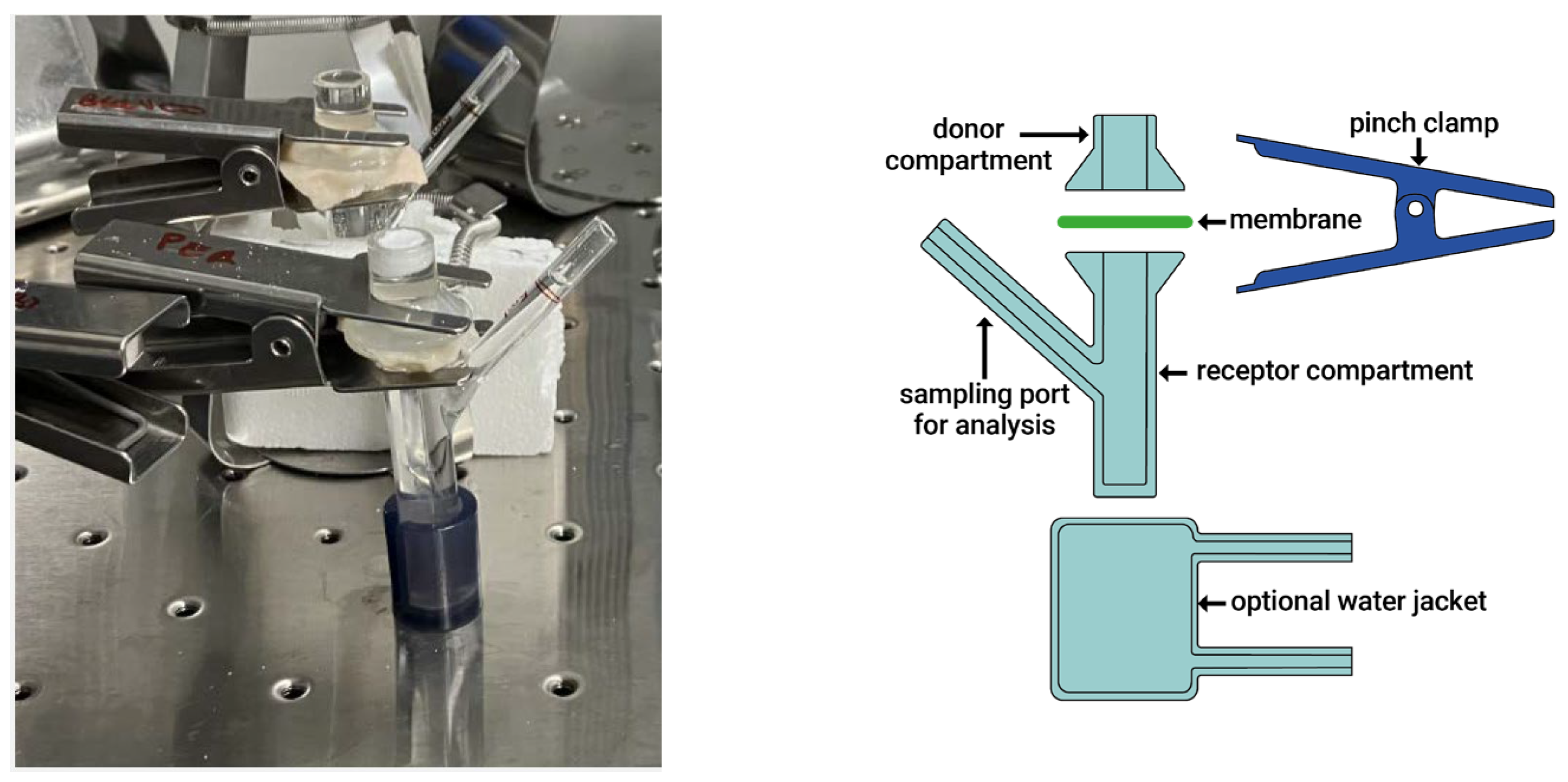
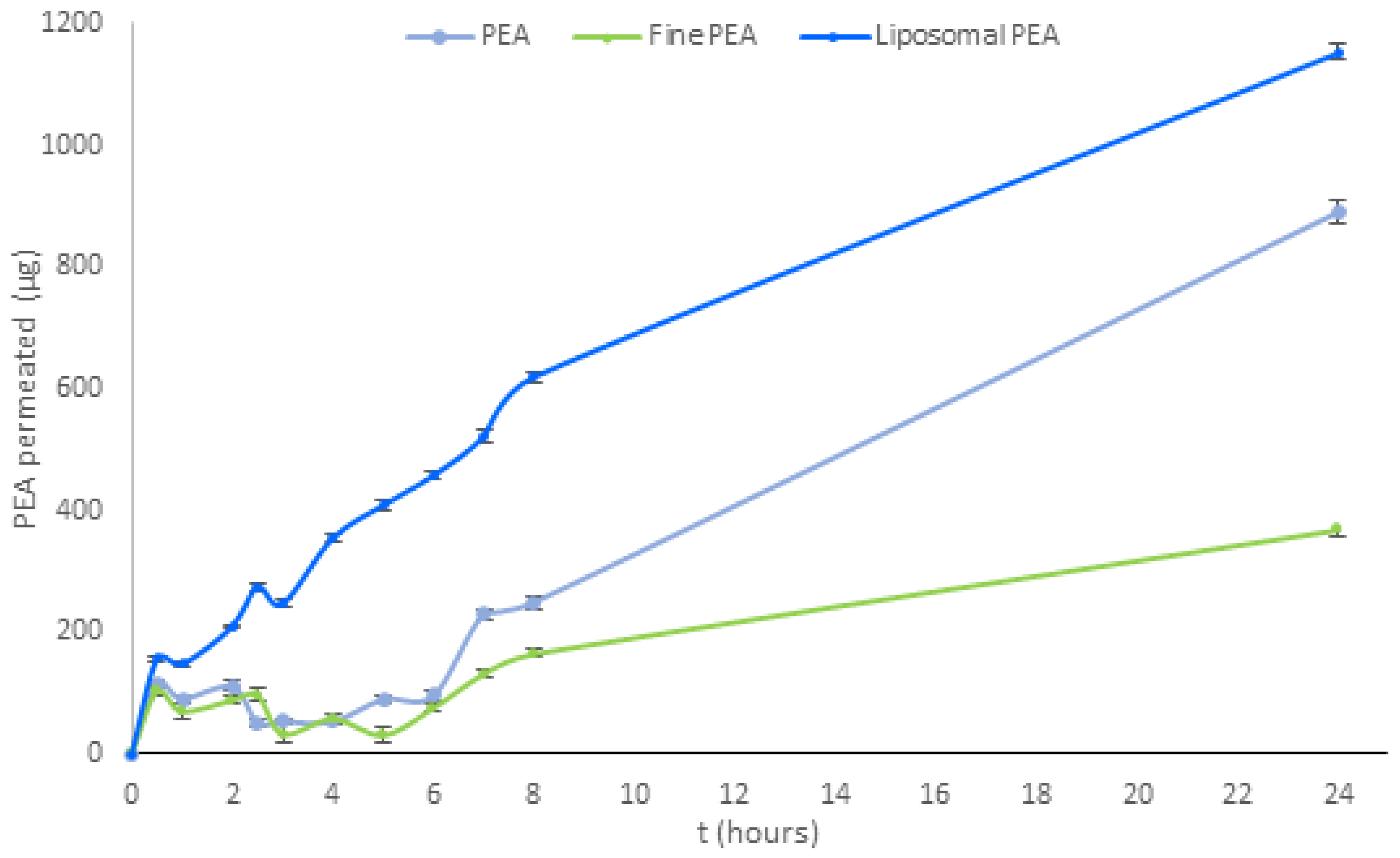
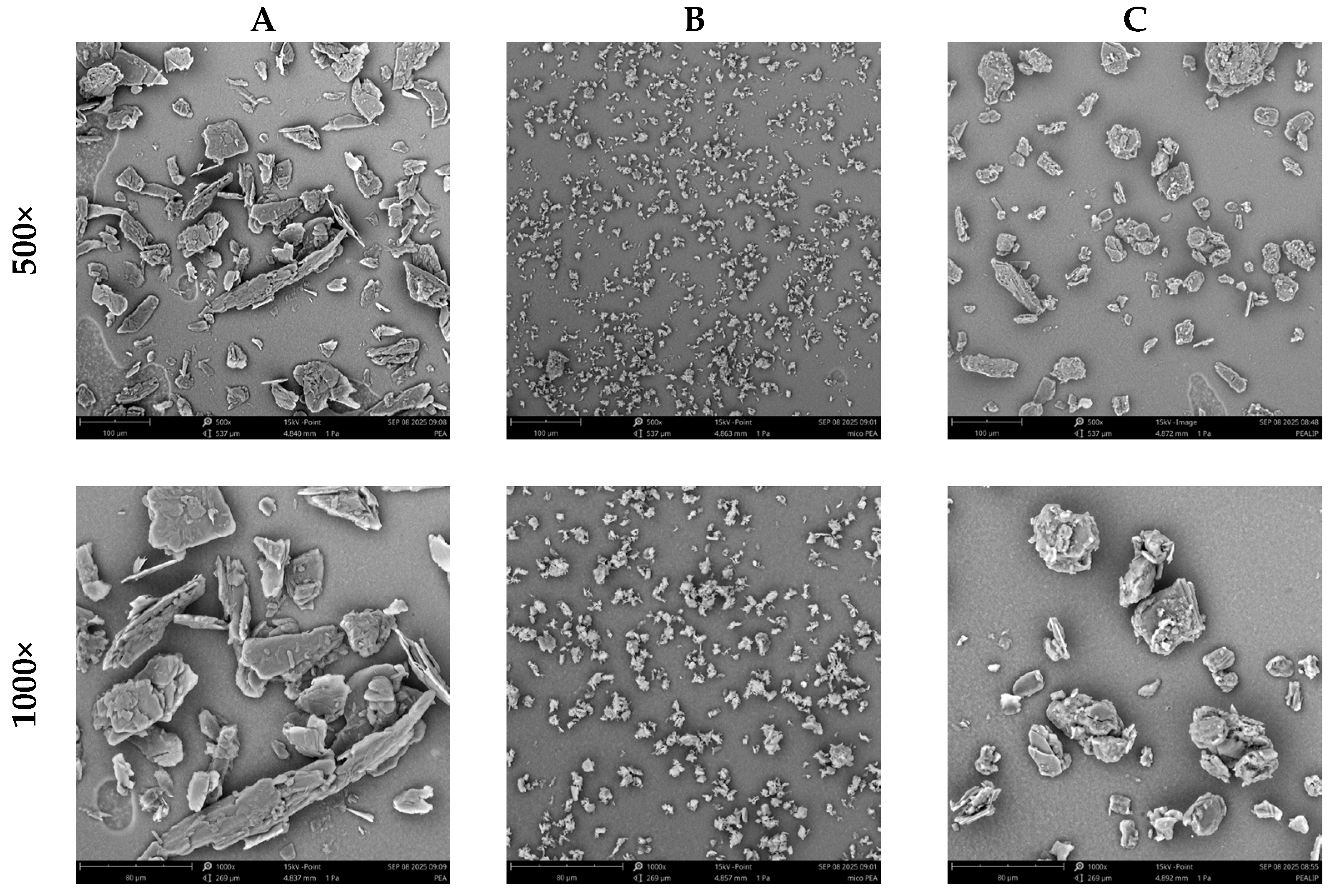
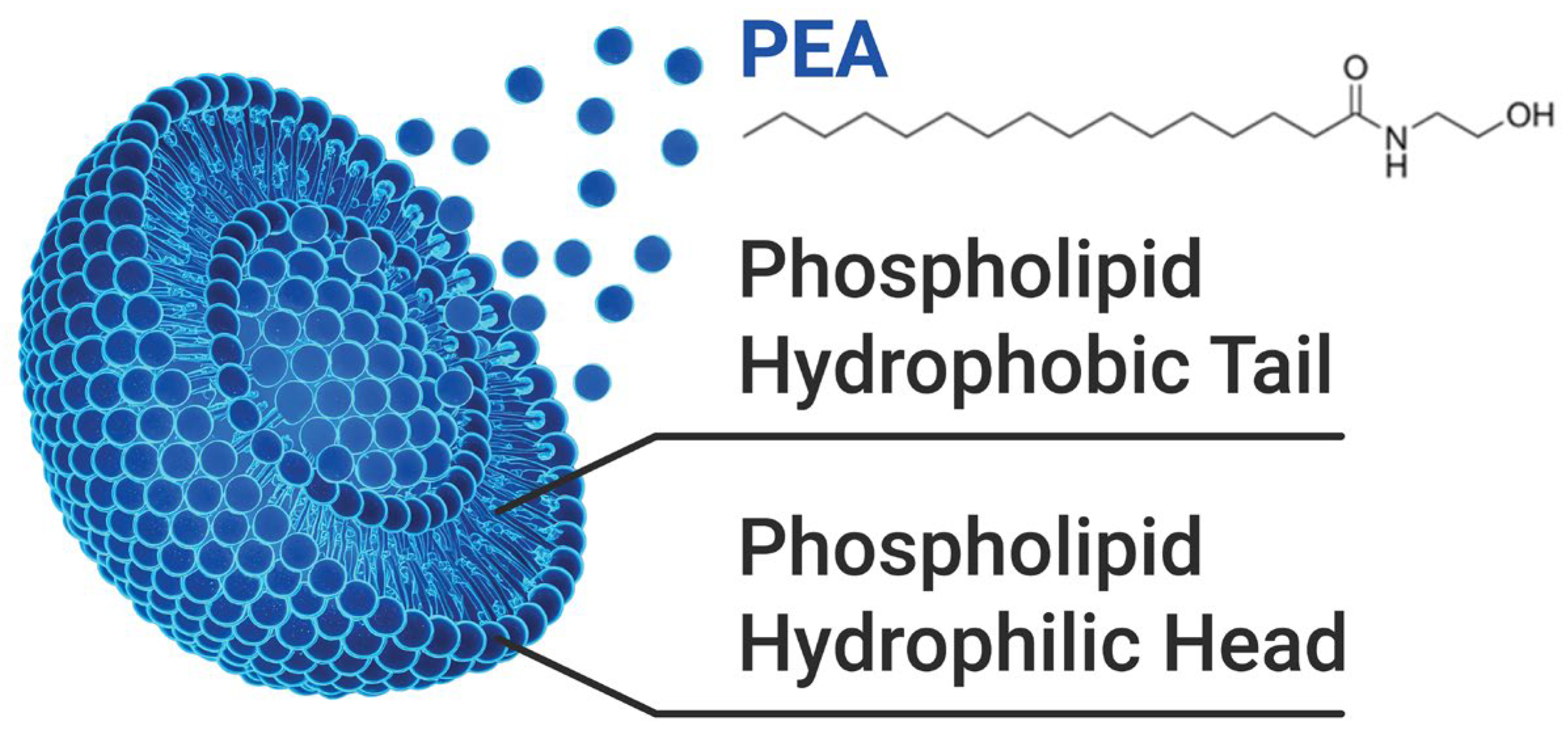

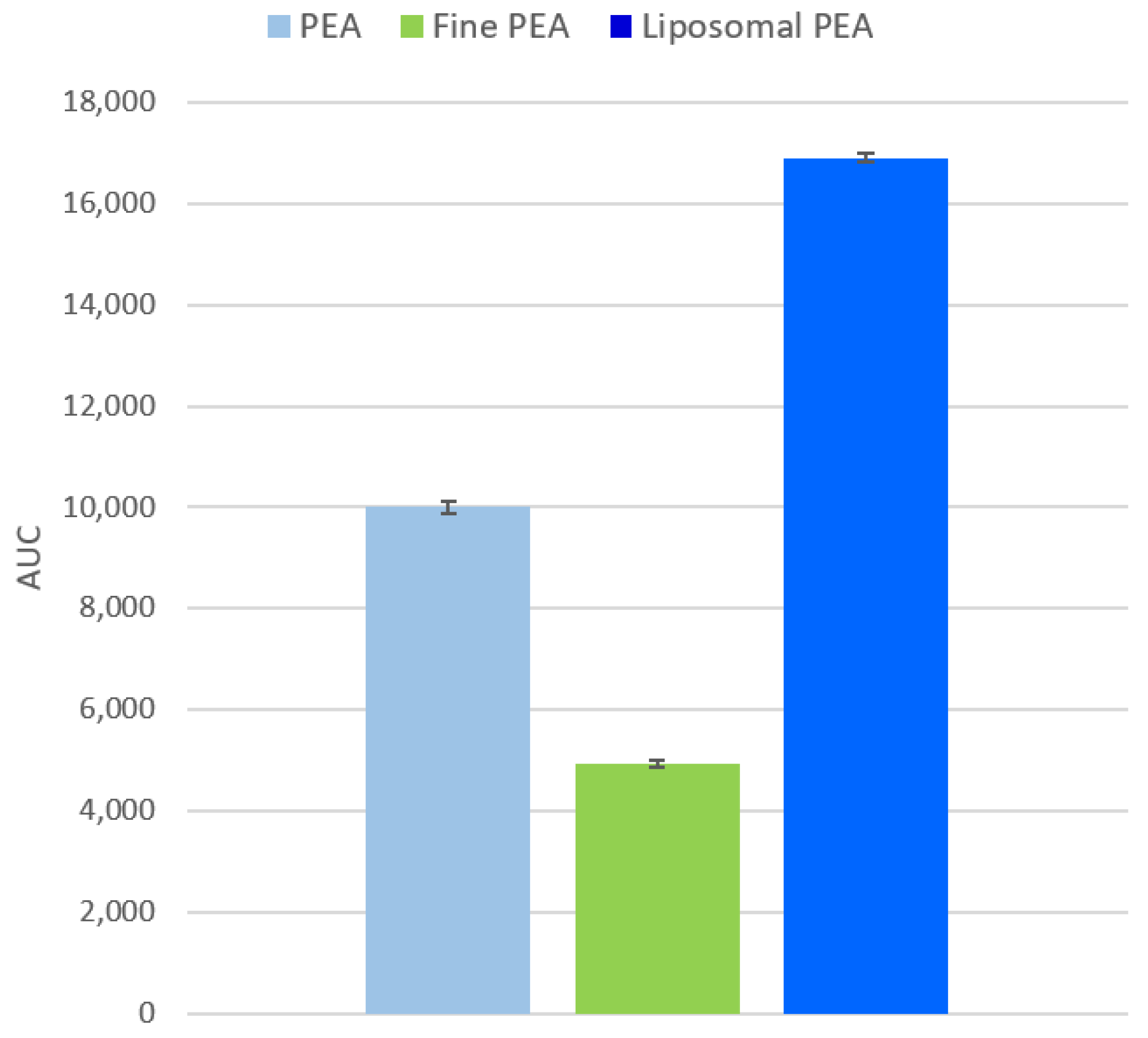
Disclaimer/Publisher’s Note: The statements, opinions and data contained in all publications are solely those of the individual author(s) and contributor(s) and not of MDPI and/or the editor(s). MDPI and/or the editor(s) disclaim responsibility for any injury to people or property resulting from any ideas, methods, instructions or products referred to in the content. |
© 2025 by the authors. Licensee MDPI, Basel, Switzerland. This article is an open access article distributed under the terms and conditions of the Creative Commons Attribution (CC BY) license (https://creativecommons.org/licenses/by/4.0/).
Share and Cite
Ceccarelli, G.; Pennetta, C.; Montalbano, F.; Licciardi, M.; Melfi, V.; Iannitti, R.G. A Novel Liposomal Palmitoylethanolamide (PEA) with Enhanced Gastrointestinal Permeating Properties. Nutraceuticals 2025, 5, 34. https://doi.org/10.3390/nutraceuticals5040034
Ceccarelli G, Pennetta C, Montalbano F, Licciardi M, Melfi V, Iannitti RG. A Novel Liposomal Palmitoylethanolamide (PEA) with Enhanced Gastrointestinal Permeating Properties. Nutraceuticals. 2025; 5(4):34. https://doi.org/10.3390/nutraceuticals5040034
Chicago/Turabian StyleCeccarelli, Giada, Chiara Pennetta, Francesco Montalbano, Mariano Licciardi, Valentina Melfi, and Rossana G. Iannitti. 2025. "A Novel Liposomal Palmitoylethanolamide (PEA) with Enhanced Gastrointestinal Permeating Properties" Nutraceuticals 5, no. 4: 34. https://doi.org/10.3390/nutraceuticals5040034
APA StyleCeccarelli, G., Pennetta, C., Montalbano, F., Licciardi, M., Melfi, V., & Iannitti, R. G. (2025). A Novel Liposomal Palmitoylethanolamide (PEA) with Enhanced Gastrointestinal Permeating Properties. Nutraceuticals, 5(4), 34. https://doi.org/10.3390/nutraceuticals5040034







